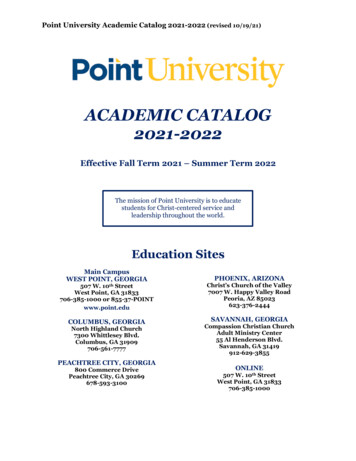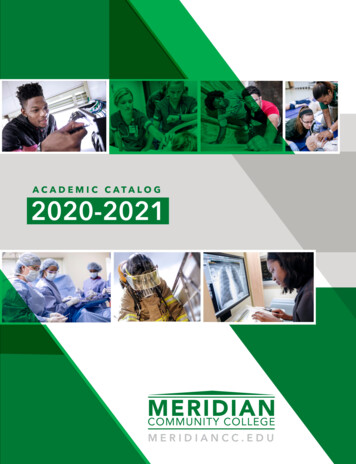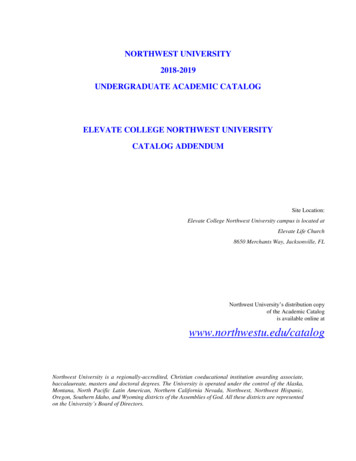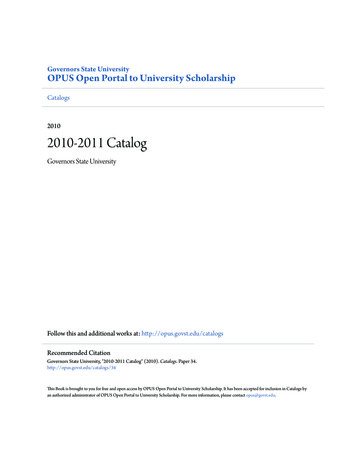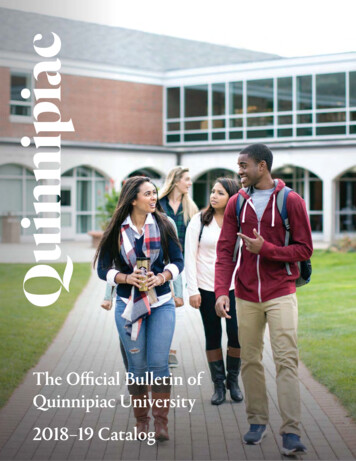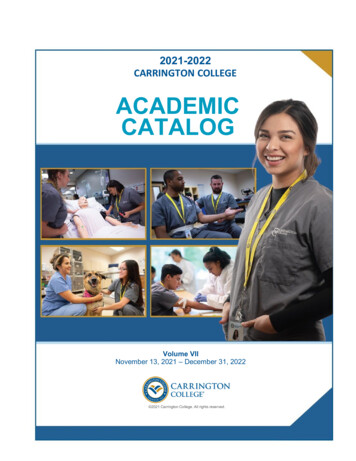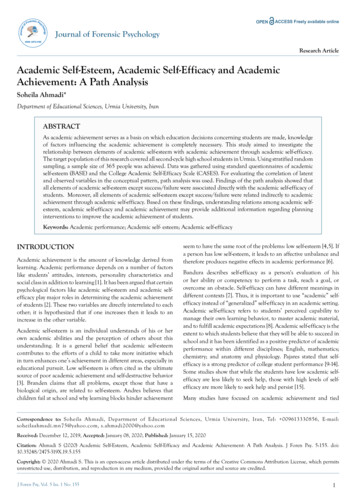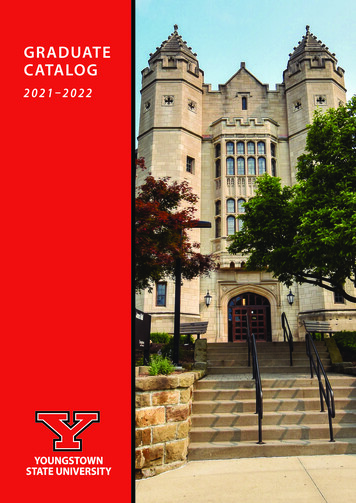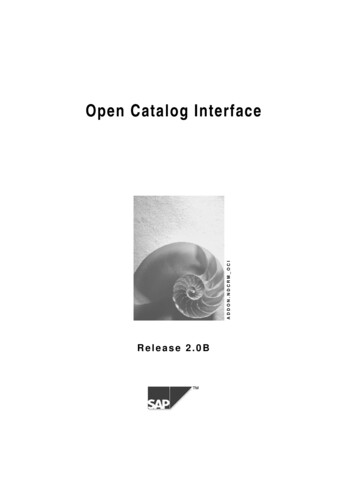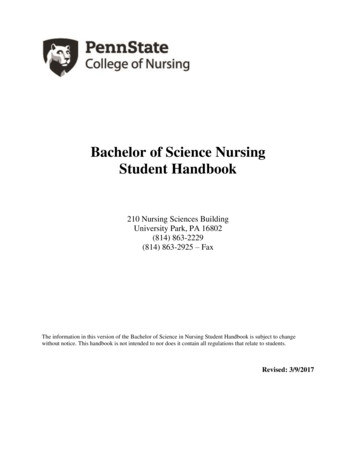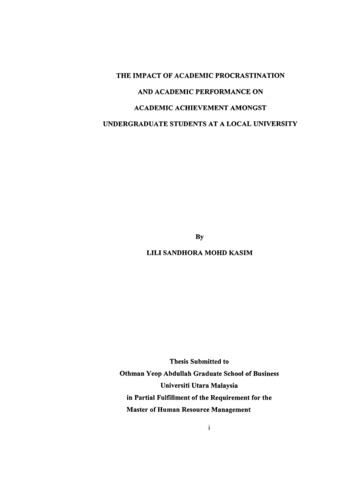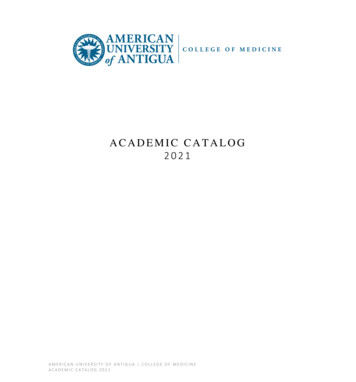
Transcription
ACADEMIC CATALOG2021AMERICAN UNIVERSITY OF ANTIGUA COLLEGE OF MEDICINEACADEMIC CATALOG 2021
TABLE OF CONTENTSMISSION STATEMENT3LETTER FROM THE PRES IDENT4ACCREDIT AT IONS AND A PPROVALS5ACADEMIC CALENDAR6CURRICULUM OVERVIEW8DEGREE CONFERRAL9GLOBAL HEALTH TRACK10PRECLINICAL SCIENCESYEAR ONE - PART ONE COURSESYEAR ONE - PART TWO COURSESYEAR TWO - PART ONE COURSESYEAR TWO - PART TWO COURSESINTERSESSION COURSE131315171921CLINICAL SCIENCESF A M I L Y M E D I C I N E / I N T E R N A L M E D I C I N E ( FM1/ I M 1 )CORE CLINICAL ROTATIONSELECTIVE CLINICIAL ROTATIONS22222327TRANSFER CREDITS AND COURSESTRANSFER CREDITCOURSE NUMBERING SYSTEM363636TERM CREDIT HOURS37ESTIMATED COST OF ATTENDANCE39SCHOLARSHIP OPPORTUNITIES40ORGANIZATION, CONTROL & ADMINISTRATION49FACULTYPRECLINICAL SCIENCESCLINICAL SCIENCES505054CONTACT INFORMATION67AMERICAN UNIVERSITY OF ANTIGUA COLLEGE OF MEDICINEACADEMIC CATALOG 2021
MISSION STATEMENT 3MISSION STATEMENTAmerican University of Antigua (AUA) College of Medicine is an innovative medical school dedicated toproviding a learner-centric education of the highest quality, offering opportunities to underrepresentedminorities, fostering a diverse academic community, and ensuring that its graduates have the skills andattitudes of lifelong learning, compassion, and professionalism. We provide students who would otherwisebe unable to receive a medical education with the tools to become successful physicians.AUA was founded with the commitment to support underserved communities and address the impendingphysician shortage with an emphasis on primary care. As such, the University recognizes its socialresponsibility to advance the field of medicine and lead the next generation of physicians and healthcareprofessionals to respond to global healthcare needs.AMERICAN UNIVERSITY OF ANTIGUA COLLEGE OF MEDICINEACADEMIC CATALOG 2020
LETTER FROM THE PRESIDENT 4LETTER FROM THE PRESIDENTThe present physician shortage, which is predicted to grow at an alarming rate over the next 20 years,means that the employment opportunities for young physicians to practice medicine throughout the U.S.and the world are limitless. New graduates have unequaled opportunities to practice their profession whileserving the public good.The failure of U.S. medical schools to provide enough medical school seats to meet demand has resultedin many extremely qualified applicants not being admitted to U.S. medical schools. The inability of U.S.medical schools to address the physician shortage and their failure to address the lack of diversity inmedicine were two major catalysts that compelled AUA’s founders to establish a medical school.AUA is proud to offer qualified applicants the opportunity to attain their dreams of becoming licensedphysicians by providing high quality, high-tech medical education facilities and, more important, highlyrespected and caring faculty. In doing so, we are addressing the physician shortage and the lack of diversityin medicine.At AUA, we view medical education as a partnership between the institution and its students. AUA offersthe necessary tools to provide you with the education that will prepare you to become a successful and caringphysician. We expect our students to provide the hard work, dedication, and compassion that allow them touse the tools we provide to reach their goals for their benefit and to serve the healthcare needs of ourpopulation.I look forward to having qualified applicants join us to achieve their goal of becoming competent caringphysicians in the U.S. and Canada and in the jurisdictions of their choice throughout the world.Neal S. SimonPresident, American University of Antigua College of MedicineAMERICAN UNIVERSITY OF ANTIGUA COLLEGE OF MEDICINEACADEMIC CATALOG 2021
ACCREDITATIONS AND APPROVALS 5ACCREDITATIONS AND APPROVALSAmerican University of Antigua College of Medicine awards Medical Doctorate (MD) degrees to its graduatespursuant to a charter granted to the University by the Government of Antigua and Barbuda. AmericanUniversity of Antigua College of Medicine is accredited by the Government of Antigua and Barbuda throughthe regional accreditation authority, the Caribbean Accreditation Authority on Education in Medicine andOther Health Professions (“CAAM-HP”). The National Committee on Foreign Medical Education andAccreditation of the United States Department of Education (“NCFMEA”) has recognized the Government ofAntigua and Barbuda as having processes and procedures for the accreditation of medical schools that arecomparable to those of the Liaison Commission on Medical Education (“LCME”), the accreditation authorityfor medical schools in the United States and Canada.American University of Antigua College of Medicine has been recognized by the Medical Board of Californiafor licensure of its graduates and for providing clerkships in the state. The New York State EducationDepartment has also approved American University of Antigua, which allows AUACOM’s students to engagein clinical clerkship training and residency in the state. The Florida Commission for Independent Educationhas likewise granted approval for AUACOM’s students to engage in clinical clerkship training in the state.AUACOM’s graduates are eligible for licensure throughout the United States and Canada. The Board ofRegistration in Medicine of the State of Massachusetts has included AUA among a very short list ofinternational medical schools whose graduates are deemed to have been provided an education that iscomparable to the education afforded students in medical schools in the United States. As a result, AUA’sgraduates seeking permits for residency training or full licensure will not need to demonstrate suchcomparability or obtain a waiver of regulations applicable to international medical schools that do not haveclinical training hospitals on their campuses.AMERICAN UNIVERSITY OF ANTIGUA COLLEGE OF MEDICINEACADEMIC CATALOG 2021
ACADEMIC CALENDAR 62021 ACADEMIC CALENDARJanuary 1FridayJanuary 4MondayJanuary 11MondayJanuary 20WednesdayJanuary 22FridayJanuary 25MondayFebruary 4 – 5February 8Thursday – FridayMondayMarch 5FridayMarch 8March 19March 20 – April 8April 2MondayFridaySaturday – ThursdayFridayApril 5MondayApril 9FridayApril 16FridayApril 19May 3MondayMondayMay 24MondayMay 28FridayNew Year’s Day Observed –University ClosedClasses begin for Global HTBSIC StudentsClasses begin for returningAUA GlobalHT Students (MED 2, 3 & 4)Classes begin for BSICstudentsClasses begin for new AUAGlobal HTStudents (MED1)Classes end for FM1/IM1termClasses begin for MED 2,3 &4FM1/IM1 term beginsNew Student OrientationClasses begin for MED 1studentsClasses end for FM1/IM1termFM1/IM1 term beginsClasses end for BSIC studentsBSIC study periodGood Friday – Classes not insessionEaster Monday – Classes notin sessionMandatory ComprehensiveBasic Science Shelf Exam forBSIC studentsClasses end for FM1/IM1termFM1/IM1 term beginsLabour Day -Classes not insessionWhit Monday – Classes notin sessionClasses end for FM1/IM1AMERICAN UNIVERSITY OF ANTIGUA COLLEGE OF MEDICINEACADEMIC CATALOG 2020
ACADEMIC CALENDAR 7May 31June 3June 4MondayThursdayFridayJune 18FridayFM1/IM1 term beginsCommencement CeremonyClasses end for MED 2, 3 & 4Comprehensive Basic ScienceShelf Exam for MED 4MED 1 endsAMERICAN UNIVERSITY OF ANTIGUA COLLEGE OF MEDICINEACADEMIC CATALOG 2020
CURRICULUM OVERVIEW 8CURRICULUM OVERVIEWAUACOM’s educational program leading to the Medical Doctorate (MD) degree is a 4.5-year programconsisting of 2.5 academic years of study on AUACOM’s campus in Antigua and 84 weeks of study in theClinical Sciences through clerkships in teaching hospitals principally in the United States.In order to provide the most innovative and current methods for delivery of a medical education, AUA’scurriculum brings medical disciplines together and fosters greater communication and cooperation betweendepartments. Although each branch of medical science has its own importance and essence, the currenttrend in medical education is the delivery of a medical school curriculum through integration of thosebranches. AUA’s curriculum has been developed with the goal of achieving an integrated and flexiblecurriculum that goes beyond examinations. It promotes the skill and art of medicine, critical thinking, andlifelong learning.AMERICAN UNIVERSITY OF ANTIGUA COLLEGE OF MEDICINEACADEMIC CATALOG 2021
CURRICULUM OVERVIEW 9DEGREE CONFERRALTo satisfy the requirements for graduation and obtain a medical diploma (MD degree), a student mustcomply with the below criteria:1. Complete and pass all requirements of the Preclinical Sciences component;2. Complete and pass all requirements of the Clinical Sciences component, including all core and electiverotations;3. Pass USMLE Step 1, Step 2 CK and CS*;*Based on the 12 to 18 month suspension of Step 2 CS by USMLE, AUA has decided to suspend passingof USMLE Step 2 CS as a requirement for graduation as well as all components of the Clinical Skillspreparation program with immediate effect.a. Students must request the USMLE Certified Transcript of Scores for USMLE Step 1, Step 2 CKand CS from ECFMG to be submitted to the Office of the Registrar as part of the degree audit;4. Fulfill all financial and bursarial responsibilities assuring a “zero” balance;5. Maintain good standing.AUA students have the opportunity to complete the requirements for the MD degree at five different pointsthroughout the year. Consequently, students will be considered AUA graduates on one of the five graduationdates after which they have completed their graduation requirements. Students completing all MDrequirements between:1.2.3.4.5.July 1 and September 30, xxxx will receive a diploma dated September 30, xxxxOctober 1 and December 31, xxxx will receive a diploma dated December 31, xxxxJanuary 1 and March 31, xxxx will receive a diploma dated March 31, xxxxApril 1 and April 30, xxxx will receive a diploma dated April 30, xxxxMay 1 and June 30, xxxx will receive a diploma based on the date of MD graduation requirementcompletionGraduates cannot receive a copy of their diploma prior to the diploma date and final degree auditclearance. Once your graduation date has passed and the final degree audit is completed, diplomas for allgraduates are mailed to the address provided in your student record.Bachelor of Science in Human Health Sciences (BHHS) DegreeThis four-year degree program will provide students who are enrolled in the MD Degree Program at AUACollege of Medicine with the opportunity to earn a B.S. in Human Health Sciences. The BHHS degree isdesigned for students who have earned their A.S. through American International College of Arts andSciences – Antigua (AICASA)* and/or do not have a B.S./B.A. degree upon enrolling in AUA College ofMedicine. Please visit the AUA website for additional information.*Degree conferred by AUA College of Medicine. AUA and AICASA are two wholly separate educationalinstitutions.AMERICAN UNIVERSITY OF ANTIGUA COLLEGE OF MEDICINEACADEMIC CATALOG 2021
GLOBAL HEALTH TRACK 10GLOBAL HEALTH TRACKThe American University of Antigua, College of Medicine (AUA) Global Health Track is conducted incollaboration with Florida International University, Herbert Wertheim College of Medicine (FIU).The AUA-FIU Global Health Track is a comprehensive, four-year longitudinal track in global health that isintegrated into the curriculum at American University of Antigua, College of Medicine.Global Health has been defined as “the area of study, research and practice that places a priority onimproving health and achieving equity in health for all people worldwide” by the Consortium of Universitiesfor Global Health. Global Health addresses the health of populations in a global context and transcends thepolitical boundaries of nations focusing on social determinants of health, healthcare disparities includinginfectious and non-communicable disease issues, human rights as well as economic development, and policyand system issues.The purpose of the AUA-FIU Global Health Track is to support and guide students in developing expertise inglobal health with the goal of a subsequent career involving patient care, service, policy making, research andeducation at a global level.Students attending the AUA-FIU Global Health Track are introduced to the study of community and publichealth, primary care, epidemiology and treatment of communicable and non-communicable diseases on aglobal basis.The required textbook is: Global Health 101, 4th edition, Richard Solnick, MPA, Yale, School of PublicHealth, New Haven, Connecticut,ISBN-13: 9781284050547The AUA-FIU Global Health Track is open to all eligible entering medical students at AUA.The longitudinal Global Health Track is structured along the following themes: Governance (Health Systems, Economics, Ethics, etc.)Burden of Disease (Child Health, Women Health and the health of other vulnerable populations,Communicable Diseases, Non-Communicable Diseases, etc.)Physical Mental & Social WellbeingTechnologySecurity (Environment, Complex Humanitarian Emergencies, Intelligence, etc.)Climate ChangeMedical SpanishAHA BLS & ACLS instructor trainingThe 2-year PRECLINICAL SCIENCES component is conducted on the campus of AUA in Antigua. It consistsof four 2-week blocks (before MED 1, MED 2, MED 3 and MED 4), a 1-week block before the Basic-ScienceIntegration course and longitudinal coursework during MED 1 through MED 4.The lectures are conducted by international faculty (FIU, University of the West Indies, State University ofNew York, Cornell University, New York University, University of Illinois, University of Nevada, UnitedAMERICAN UNIVERSITY OF ANTIGUA COLLEGE OF MEDICINEACADEMIC CATALOG 2020
GLOBAL HEALTH TRACK 11Nations, Doctors Without Borders among others) and AUA faculty.In addition, students conduct field trips and exercises and are introduced to research methodology.Students in the Global Health Track receive American Heart Association instructor training in Basic CardiacLife Support and Advanced Cardiac Life Support.The Preclinical Sciences component includes an introduction to Medical Spanish and is supplemented by aGlobal Health Journal Club. A minimum of 100% attendance is required in order to pass each block. Allstudents enrolled in the course will receive either a grade of “PNC” (Pass No Credit) or “F” (Fail)accordingly. “The “PNC” grade will not affect overall GPA, therefore no credits will be awarded.To facilitate students’ academic success, students who either choose or are required to repeat the term oryear during the preclinical years will no longer be able to stay enrolled in the Global Health Track programand may not rejoin GHT after completion of a repeated semester or year. Additionally, students whovoluntarily withdraw from the preclinical GHT will not be able to rejoin at a later date.The CLINICAL SCIENCES component is conducted at FIU’s clinical sites in Florida and AUA affiliatedclinical sites within the US and abroad. Students will participate in the Advanced Introduction to ClinicalMedicine (FM1/IM1) rotation at FIU and the AUA-FIU Graduate Clinical Core Rotation Certificate Program(upon successful completion of requirements and acceptance by the graduate certificate program admissioncommittee). After completion of the graduate clinical core rotation certificate program, students attendelective rotations through FIU and AUA in the US and internationally. Students have the opportunity to joinAUA faculty initiated international relief projects and to deepen their expertise in global health research. Theclinical component is supplemented by medical Spanish exposure.100% attendance is required during the clinical component.At the completion of the program, a student should be able to: Demonstrate understanding of social determinants of health, health equity, social justice, andgovernmental policy in terms of their impact on the distribution of health services and healthoutcomes in low-resource settings within the United States and internationallyAnalyze the challenges facing the health and human rights issues specific to immigrant, migrant,internally displaced, and refugee populationsUnderstand specific needs of vulnerable populations including the medically underserved anduninsuredDemonstrate knowledge of effective advocacy strategies for health systems improvement within theglobal contextDemonstrate the ability to communicate effectively and collaborate with the patient, family, andcaregivers with sensitivity to sociocultural and health literacy issues so that the diagnosis and plan ofcare are clearly understood and pertinent to their specific situationUnderstand the epidemiology of global communicable and non-communicable diseasesIdentify and adapt evidence-based resources and tools for use in limited-resource health care settingsInteract in a cross-cultural manner sufficient to deliver basic medical care, including working withtranslatorsPerform an efficient comprehensive physical examination when practicing supervised in aninternationally located office, hospital, or skilled nursing setting, being mindful of cultural factors,including gender, modesty, and religious practicesAMERICAN UNIVERSITY OF ANTIGUA COLLEGE OF MEDICINEACADEMIC CATALOG 2020
GLOBAL HEALTH TRACK 12 Use clinical skills to appropriately diagnose and treat patients under supervision in the context oflocal resource availabilitySelect, perform, and interpret under supervision diagnostic procedures within the context of limitedresource health care settingsFormulate a plan of care that is relevant and practical in a specific cultural settingDemonstrate understanding of resources and issues pertinent to travel medicine, health riskprevention, health maintenance, and variations in health care services that are specific tointernational travelDiscuss treatment plans based on knowledge of global influences, utilizing resources that includelocal, state, federal, and international agencies, as applicableRecognize his or her own practice limitations and seek consultation with other health careprofessionals and systems resources to provide optimal care within a global contextUnderstand the organization, financing and systems health indicators of international health caresystems.The student should develop attitudes that encompass: Commitment to lifelong learning and contribution to the body of knowledge about global healthRecognition of his or her own biases and stereotypes related to health care delivery in internationalsettingsThe need to balance compassion, humanism, realism, and practicality in the consideration of heathcare delivered in specific global settingsRespect for dignity and autonomy through self-care and self-determination within a cultural andglobal contextA desire to advocate for systems change to improve the health of the community in which he or shepracticesUpon completion of the Global Health Track, completion of requirements of the Graduate Clinical CoreRotation Certificate Program and all requirements for graduation from AUA (including but not limited topassing all in-house and external exams and passing all required courses and clerkships) the student willreceive the MD degree and the Global Health Certificate from AUA as well as the certificate of completion ofthe Graduate Clinical Core Rotation Certificate Program from FIU.AMERICAN UNIVERSITY OF ANTIGUA COLLEGE OF MEDICINEACADEMIC CATALOG 2020
CLINICAL SCIENCES 13PRECLINICAL SCIENCESReadings for Classes:What the Library ProvidesAny reading required for a particular class will be available via Blackboard, AUA’s online coursemanagement system. Just as links to lectures, videos, and PowerPoint presentations are linked inBlackboard, links to readings will also be provided. The AUA Library will also have print copies of each of therequired and recommended books put on reserve. In addition, hundreds of other e-books, e-journals, andmedical knowledge-bases are now available to AUA students both on campus, and off campus via their AUANetID.Personal Copies of TextbooksStudents wishing to purchase personal print copies of textbooks or personal e-books are welcome to do so.As textbooks required for a given course are subject to change each term, students should the contactsystems coordinators for each course before making a purchase.For more information, contact Laura Cousineau, Director of Library Services, at lcousineau@auamed.net.YEAR ONE - PART ONEPRE-CLINICAL SCIENCE ICredit Hours: 19 Course No: 5116FOUNDATIONS I - SPRING 2021The Foundations block will lay the groundwork for preclinical medical sciences, in general, and for all of thesystems that will be following, in particular. It will take the approach of presenting the continuum from therelevant basics of molecules to the system level and include considerations for evidence-based decisionmaking.The Foundations of Preclinical Medical Sciences block will start with the story of cells, including thestructure and function of organelles. The story will develop into tissues and include themes such as thedevelopment of an embryo, connective tissue, epithelia and muscle. Finally, an assemblage of thisinformation will take the form of a brief introduction to systems. Weaved into this approach will befundamental aspects of various disciplines, such as cell and molecular biology, genetics, biochemistry,anatomy, embryology, histology, neuroscience, behavioral science, and radiology.The course material will be presented as interactive lectures and active small group discussions guided byfacilitators. The learning materials (Class notes/ PowerPoints/ Videos, etc.) will be posted on Blackboard inadvance so as to facilitate students’ preparation for in-class activities and exams.We look forward to a stimulating five weeks of Foundations of Preclinical Medical Sciences discussions withyou.AMERICAN UNIVERSITY OF ANTIGUA COLLEGE OF MEDICINEACADEMIC CATALOG 2021
CLINICAL SCIENCES 1 4MUSCULOSKELETAL SYSTEM/SKIN I -SPRING 2021Musculoskeletal System/Skin will be the first system you study in this organ system based curriculum. Inthis module you will learn the preclinical sciences principles of the muscular, skeletal and integumentarysystems. The module spans 3 weeks with each week having an underlying theme: week 1- upper limb, week2- lower limb and week 3- head, neck and back. Focus will be on anatomy, biochemistry, embryology,histology, neuroscience, physiology, and radiology disciplines with clinical correlations as appropriate. Inthis module, students will gain knowledge of the locomotor system which affords support, stability andmovement to the human body and the application of this knowledge.The overarching goals of this System are to: (1) Study the general structure and function of bones, joints andmuscles, their blood and nerve supply and to introduce their relevance to clinical problems. (2) Study thestructure and function of the upper limb, lower limb, head and neck and the vertebral column includingsurface anatomy, neurovascular supply and coordination for movement. (3) Provide the basis for the studyof common clinical conditions, disorders and clinical examination related to the above regions to be done inthe second year.The course material will be presented as interactive lectures and active small group discussions guided byfacilitators. Learning material (Class notes/ PowerPoints/ Videos, etc.) will be posted on Blackboard beforethe lecture or small group activity so as to facilitate students’ preparation for the sessions. As you progressthrough this module, you will build on fundamental principles learned in the foundations module and theirapplication to this organ system.NEUROSCIENCE & BEHAVIORAL SCIENCES I - SPRING 2021The Neuroscience & Behavioral Science System spans 5 weeks and has two major themes. The first is anintroduction to Neuroscience, including both Neuroanatomy and Neurophysiology. The module will addressembryonic development of the central and peripheral nervous systems. Specific emphasis will be given to thecentral nervous system (CNS), including the cranial and spinal nerves, the structure and function of the CNS,and the neurophysiology of sleep and hearing.The second theme is an introduction to Behavioral Science. Behavioral Science will elucidate thepsychological aspects of human development across the lifespan and the developmental milestonesphysicians need to know. Wewill also address doctor/patient communication, death & dying, culture in medicine, operant and classicalconditioning, psychodynamic theory andpractice, and will give students exposure to defense mechanisms.All of this is designed to serve as a foundation for the Behavioral Science & Neuroscience System taught inthe second year at AUA. The focus for that system will be on neuropathology and psychopathology.The Neuroscience & Behavioral Science System material will be presented in both large group and smallgroup formats. Case studies and other small group exercises will be emphasized. All reading assignments,and other course materials will be available on Blackboard prior to each activity.AMERICAN UNIVERSITY OF ANTIGUA COLLEGE OF MEDICINEACADEMIC CATALOG 2020
CLINICAL SCIENCES 1 5GASTROINTESTINAL SYSTEM I - SPRING 2021Welcome to the study of the gastrointestinal tract. Over the next 4 weeks you will explore what happens tofood when it enters the body; the course it takes, and how it is converted to energy and into building blocksfor the body that are essential for growth and daily functioning. You will also gain greater appreciation ofwhat happens to the unutilized remainder of the food that is removed from the body. In other words, youwill study the journey of what you consume from the plate to the potty!In the first week, you will learn how the gastrointestinal tract is formed at the embryonic stages and thesignificance of embryonic development from a clinical perspective. You will review what happens in the oralcavity and why its structure is suited for its function of preparing the food for digestion while you savor eachbite. The structure of the anterior abdominal wall will also be reviewed. There is far more to learn than thesix-pack: the anterior abdominal wall is the book-cover for the clinician for several gastrointestinal ailments.Understanding its structure is essential.Most of the process of digestion beyond swallowing occurs without us thinking about it. In the second week,you will learn the special characteristics of the esophagus and stomach. You will study their innervation toeffect motility and the neuro-hormonal signals used orchestrate the transfer of food from the mouth to thestomach and breakdown of food into simpler absorbable units.In the third and fourth weeks you will gain further appreciation of how the gut wall changes structure to suitfunction: from food transport to breakdown to absorption. You will study how the liver, gallbladder andpancreas contribute to the digestive process and how food turns into energy or is stored for later use. Youwill also delve into how your body regulates energy availability during times of fasting and starvation. Lastbut by no means least, you will study how you store and release the waste products of digestion in acontrolled and socially acceptable manner. Be mindful that throughout the GI tract problems may arise thatwill lead to disease. There are common trouble spots. Become very familiar with the normal process ofdigestion so that you will appreciate diseases and their causes next year. The course material will bepresented as interactive lectures and active small group discussions guided by facilitators. Learning material(Class notes/PowerPoints/Videos, etc.) will be posted on Blackboard before the lecture or small groupactivity, so as to facilitate students’ preparation for the sessions.YEAR ONE- PART TWOPRE-CLINICAL SCIENCE ICredit Hours: 19 Course No: 5216CARDIOVASCULAR SYSTEM I – SPRING 2021The Cardiovascular System I is a 5-week module that explores the structural, biochemical and functionalaspects of the human cardiovascular system through cooperative learning activities supported by interactivelectures and textbook readings. The small group learning activities are highlighted by discussions of casebased problem-solving exercises. These exercises are based on the key components of the system—the heartis the source of energy for blood flow and delivery of nutrients to the body. The blood, lymph and bloodvessels, which comprise the systemic circulation, are considered both as a macro-circulation and as a microcirculation. Interactions between the cardiovascular and gastrointestinal systems are considered tounderstand how nutrients are delivered to each of the human body’s estimated 37.2 trillion cells, includingthe heart itself. Interactions between the cardiovascular and nervous systems explain the tight couplingAMERICAN UNIVERSITY OF ANTIGUA COLLEGE OF MEDICINEACADEMIC CATALOG 2020
CLINICAL SCIENCES 1 6between blood flow and neural signaling which include regulating all of a human’s thoughts, emotions andbehaviors. How the cardiovascular system adjusts to the stresses of physical exercise and heart failureprovides a comprehensive review of the facts, concepts and interactions to demonstrate mastery of thenormal cardiovascular system. Diligent study and immersion in all the Cardiovascular System block’slearning activities are sure to build confidence and readiness to apply their knowledge of the normalcardiovascular system to the differential diagnosis of cardiovascular system diseases. The learning materials(Class notes/PowerPoints/Videos, etc.) will be posted on Blackboard to facilitate students’ advancedpreparation for in-class activities and exams.RESPIRATORY SYSTEM I – SPRING 2021Respiratory system in year one will focus mainly on the basics of structure
pursuant to a charter granted to the University by the Government of Antigua and Barbuda. American University of Antigua College of Medicine is accredited by the Government of Antigua and Barbuda through the regional accreditation authority, the Caribbean Accreditation Authority on Education in Medicine and Other Health Professions ("CAAM-HP").
